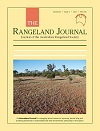RJ21036Prospects for sustainable use of the pastoral areas of Australia’s southern rangelands: a synthesis
This paper provides an overview of the characteristics of Australia’s southern rangelands, the impacts of pastoral land use on the 54% of the region used for extensive grazing, and proposes four principles and 19 guidelines to underpin sustainable pastoralism. Although it is recognised that pastoralism will necessarily contract in some areas because of limitations on production and profitability, outside of these areas, we argue, that pastoralism has good prospects for ecological, economic and social sustainability if conducted in accordance with the principles and guidelines proposed. Emerging alternative industries are also described and have potential to contribute to sustainable land use across the region more generally.
RJ21036 Abstract | RJ21036 Full Text | RJ21036PDF (555 KB) Open Access Article





